
views
- Unlock or start the car with your car key or key fob. Avoid hitting the panic button by mistake.
- Remove the alarm fuse from the car’s fuse box with pliers to stop the alarm. Put the fuse back in to reset it.
- If all else fails, disconnect the car’s battery (and any backup batteries). Wait for the computer to reset, then reconnect the battery.
Using Keys or a Key Fob
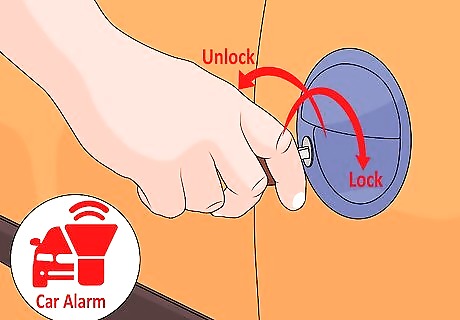
Use the key to lock and unlock the driver’s side door. Many factory car alarms are designed to turn off when in proximity to the appropriate key or key fob. You may be able to shut your car alarm down simply by inserting your key into the lock on the driver’s side door, locking it, and unlocking it again. Because the car is being unlocked by the appropriate key, it may send a signal to the alarm that it can shut down. While the passenger side door may work, it is more likely it will work on the driver’s side. If the door is already locked, simply unlock it. If the alarm doesn’t stop, try locking it an unlocking it again.

Use the key fob to lock and unlock the door. Using a similar methodology to the key method, unlocking the vehicle’s doors with the key fob will also shut down many factory car alarms. When standing close enough to the vehicle for your key fob to reach, press the lock button followed by the unlock button. Many car alarms will shut down when the car doors are unlocked by the keys or appropriate key fob. If the door locks do not respond, the batteries may be dead in the key fob. Replace the batteries and try again. If the doors unlock and the alarm continues to go off, there may be a specific way to turn off the alarm for the aftermarket model you may have. If it has a "switch" turn it to the "on" position. Hold the black button down and press the gas pedal at the same time while the key turned to the on position in the ignition. Hold until you hear fast beeps indicating the alarm has been reset.
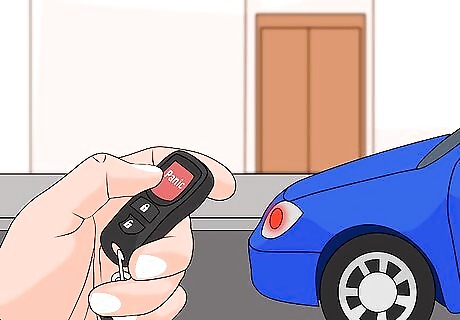
Make sure you haven’t hit the panic button. Most key fobs have an orange or yellow button on them commonly referred to as a “panic button.” This button activates something very similar to a car alarm. The horn will honk and the lights will flash. If you accidentally hit the panic button, it may continue until you press the button again. In some cars, you may be able to shut down the panic mode by starting the car and driving it. Most panic alarms will shut off on their own after a certain amount of time. The panic alarm may not shut off when you start the car, but will if you begin to drive.
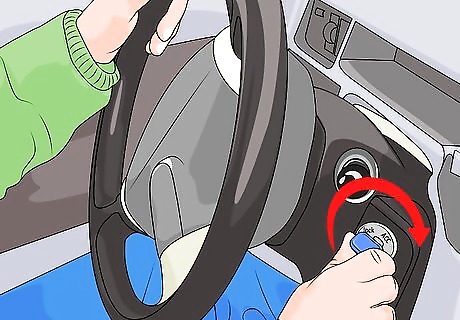
Start the car. Your alarm is designed to prevent your vehicle from being stolen by someone without a key, so starting the car with the ignition key is often sufficient to power down your car alarm. Unlock the door and enter your vehicle. Insert the key and turn it to “ACC” (accessories). If the alarm persists, attempt to start the car. Remember that some aftermarket alarms may not allow you to start the car with the alarm sounding, even with the key. Turning the key in the ignition should reset the alarm, but that may not always be the case.
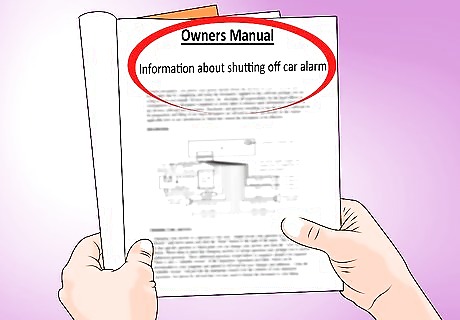
Read the owner’s manual. Standing next to a car with a blaring alarm may not strike you as the best time to do some light reading, but your vehicle’s owner’s manual can likely provide you with important information about shutting off your car alarm. If you are unable to shut the alarm off with your keys or key fob, check the owner’s manual for instructions on what to do. Every auto maker uses different car alarms, so some may require a specific action be taken before the alarm will shut down. You may need to repeat an action a certain number of times to reset the computer, such as locking and unlocking the door.
Removing the Alarm’s Fuse

Locate the appropriate fuse box. Most modern vehicles have more than one fuse box located throughout the vehicle for various electronic components. Use the vehicle’s owner’s manual to identify the box with the fuse powering your factory car alarm. The fuse box may be located in the engine bay or the cabin of the car. If it is located in the cabin, you may need to remove some trim pieces to be able to access it. Be careful when removing plastic trim pieces of your interior, as they may be brittle and prone to breaking. Place trim pieces off to the side to ensure you don’t step or sit on them as you work. A key is typically required to gain access to the fuse boxes on newer vehicles.

Identify the fuse for the car alarm. Many fuse boxes will have a diagram on the underside of the fuse box cover. If there isn’t one there, check in the vehicle’s owner’s manual as well. Identify the fuse in the diagram that powers the car alarm, then locate its corresponding fuse in your vehicle. If you do not have a diagram on the cover or in the manual, you will need to utilize the “guess and check” method of locating the fuse for the alarm in the next step. You may be able to locate a diagram of your fuse box online if you don’t have one available to you. The fuse box diagram will be in your vehicle’s repair manual if you have one.
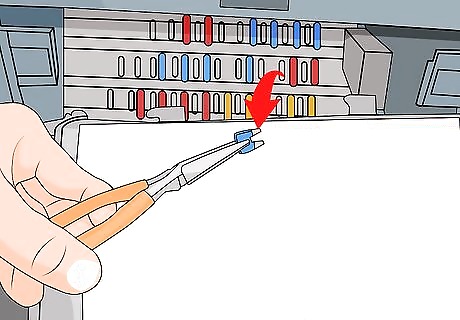
Remove the fuse with pliers. Once you have located the correct fuse, use a pair of needle nose pliers or plastic tweezers designed to remove automotive fuses to pull the fuse out of its location in the fuse box. The alarm should power down immediately with the fuse removed. If you were unable to identify which was the correct fuse using a diagram, remove and replace fuses one at a time until you remove the one that makes the alarm stop. The alarm will shut off immediately when you remove the correct fuse. Some aftermarket car alarms may not have a fuse in the fuse box.

Replace the fuse and see if it starts again. Use the pliers or tweezers to slide the fuse back into place once the alarm has shut off. The alarm should be reset and should not turn back on once the fuse has been reinserted into the fuse box. If the alarm reactivates as you slide the fuse back into place, it means the alarm is not functioning properly. If the alarm comes back on, you will likely need to take the vehicle to be repaired by a professional. If the alarm comes back on a few minutes after you reinsert the fuse, something must be setting it off, such as a faulty key fob or an issue with the electronic control unit of the vehicle.
Disconnecting the Battery

Put on the appropriate safety gear. Before doing any work on your vehicle, you should always make sure to put on the appropriate safety gear. Because there is a risk of sparks when working with an automotive battery, wear safety glasses or another form of eye protection before attempting to disconnect it. You may also want to wear gloves to protect your hands from the heat of the engine bay as well as from pinches and cuts. Always wear eye protection when working on your vehicle, especially when dealing with electrical components. Gloves can protect your hands from pinches, scrapes and the heat of the engine bay.
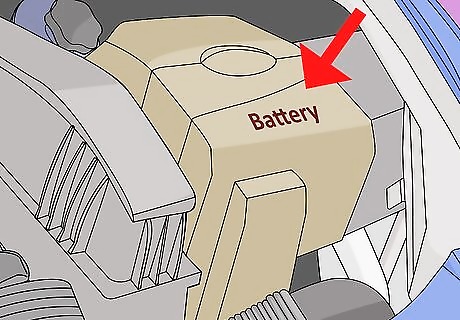
Locate the battery. You can usually find the battery for your vehicle under the hood in the engine compartment, but some automakers opt to put their batteries in the trunk to save space or improve weight distribution. When a battery is in the trunk of a vehicle, it is often under a carpeted piece of wood separating it from the trunk compartment and may be located alongside your spare tire. If you are having difficulty locating your battery, refer to your owner’s manual to help you find it. There may be a protective cover over your battery in the engine bay that you may need to remove in order to find it.

Disconnect the ground wire from the negative terminal. You can identify the negative terminal by following the thick black cable connecting it to the body of the car or by looking for the letters “NEG” or the symbol (-) above one of the two battery terminals. Using a wrench or pair of pliers, loosen the nut holding the black ground cable to the negative terminal on the battery. You will not need to remove the nut completely, just loosen it enough to be able to slide the cable off of the terminal. The alarm, as well as everything else electronic in the vehicle, should shut off immediately. Tuck the ground cable alongside the battery to ensure it can’t accidentally come back into contact with the negative terminal. You will not need to remove the positive cable from the battery.
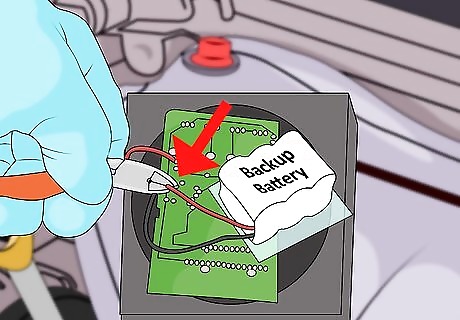
Disconnect any alarm backup batteries. Some aftermarket car alarms come equipped with a small backup battery that will keep the alarm functioning after the battery for your car has been disconnected. These batteries are not designed to power the alarm, horns and lights for long. Their primary role is to keep the alarm in working condition while you work on your vehicle so you don’t have to reset anything when reconnecting your primary vehicle battery. Refer to the user manual for the alarm system, or owner’s manual for the vehicle for factory installed backup batteries, to locate and disconnect the backup battery as well. Most factory alarms do not come equipped with a backup battery. If you are unable to locate the backup battery, it will eventually die if disconnected from the primary battery for too long.
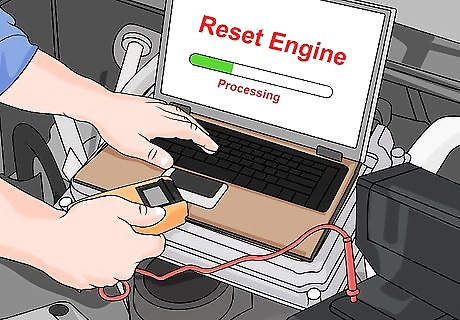
Wait for the computer to reset. Depending on the vehicle, the amount of time required for the computer to reset can vary widely. You may want to leave the vehicle disconnected for up to an hour to ensure the alarm and the vehicle’s ECU (Electronic Control Unit) have both been forced to reset due to a lack of power. Forcing your vehicle’s computer to reset will also result in losing your radio station presets and having to reset the clock in your vehicle.

Reconnect the battery. After waiting an hour or so, reconnect the ground cable to the negative terminal on the battery. Tighten the nut that secures the cable to the terminal and check it to make sure it can’t jiggle loose. If the cable were to become disconnected while you were driving, it would shut the car off. The alarm should not go off when you reconnect the battery. If it does, you will need to have your vehicle repaired by a professional. Ensure the battery cables are secure and replace any covers you may have removed to gain access to the battery. Start the car to make sure there are no further issues.















Comments
0 comment